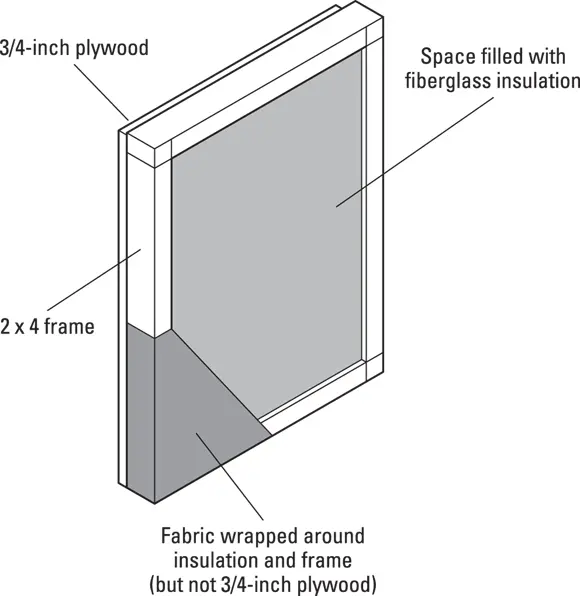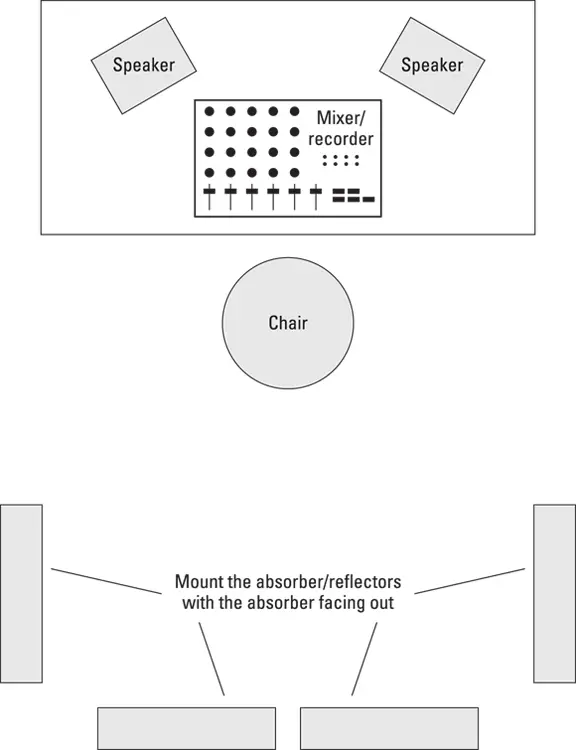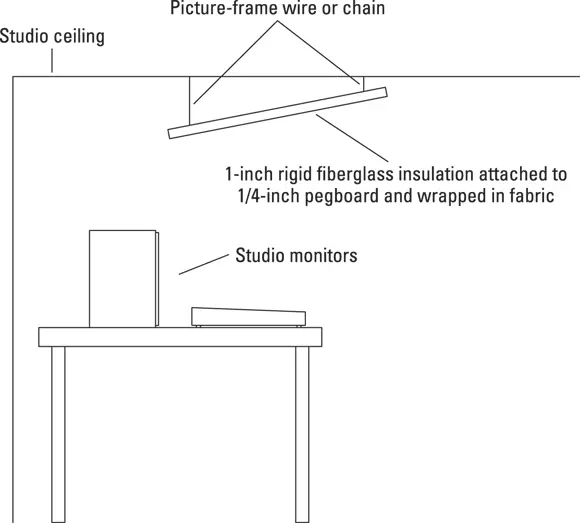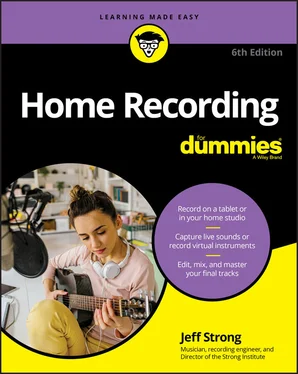 You can find out more on room modes, as well as discover some room mode calculators, by searching the Internet for “room modes.” I recommend that you research these modes; this topic alone could fill an entire book.
You can find out more on room modes, as well as discover some room mode calculators, by searching the Internet for “room modes.” I recommend that you research these modes; this topic alone could fill an entire book.
At the risk of offending professional acoustical engineers, I’m going to share some tricks that I’ve been using in my studios. My main goal has been to create a room with a sound I like that gives me some measure of control over the reflections within the room. Because I (and most home recordists) both record and mix in one room, it’s helpful to be able to make minor adjustments to the acoustics to get the sound I want.
Sound control plays a major role in two aspects of recording — tracking and mixing — and each requires different approaches for you to get the best possible sound from your recordings. I cover both of these aspects in the sections that follow.
Sound control during tracking
Tracking is what you’re doing when you’re recording. Two things that can make a room a bad environment for tracking are not enough sound reflection and too much sound reflection.
When tracking, your goal is to have a room that’s not so dead (in terms of sound reflection) that it sucks the life out of your instrument and not so alive that it over-colors the sound. The determining factors in how much reflection you need in your room are the instrument that you record and the way it sounds in the room. If your room is too dead (with not enough sound reflection), you want to add some reflective surfaces to liven things up (the room, that is). If your room is too alive (with too much sound reflection), you need to add some absorptive materials to tame those reflections.
You could buy a bunch of foam panels to catch the reflections or install a wood floor or attach some paneling to the walls to add some life, but then you would be stuck with the room sounding only one way. It may end up sounding good for recording drums or an acoustic guitar, but it would probably be too alive for getting a great vocal sound — which requires a deader space. One solution that works well is to get (or make) some portable panels that can either absorb or reflect the sound.
 Figure 3-15 shows an absorber/reflector that I’ve used and found to work well. One side has an absorptive material (dense fiberglass insulation), and the other has a reflective surface (wood). They’re assembled in an attractive frame and designed to stack easily. Even with minimal woodworking experience, you can crank out a set of them in a weekend for very little money (about $50 per panel). I guarantee that if you make them (or hire someone to make them for you), you’ll find dozens of uses for them around your studio.
Figure 3-15 shows an absorber/reflector that I’ve used and found to work well. One side has an absorptive material (dense fiberglass insulation), and the other has a reflective surface (wood). They’re assembled in an attractive frame and designed to stack easily. Even with minimal woodworking experience, you can crank out a set of them in a weekend for very little money (about $50 per panel). I guarantee that if you make them (or hire someone to make them for you), you’ll find dozens of uses for them around your studio.

FIGURE 3-15:Portable absorbers/reflectors make changing the sound characteristics of your room quick and easy.
Here are two great video tutorials that explain how to make acoustic panels:
Vo Tech Guru: How to Build Acoustic Panels ( www.youtube.com/watch?v=GBHYiWIJhUA )
Recordeo: How to Make Your Home Studio Sound Amazing With a Low Budget ( www.youtube.com/watch?v=qBy63yKkoqQ )
Sound control during mixing
The following sections detail the steps that can help you control the sound of your (probably less-than-perfect) room during mixing.
 You can skip (or delay) the following steps if you have a good pair of headphones. Headphones also allow you to cross-reference your mix’s sound when you do mix with speakers in a good room.
You can skip (or delay) the following steps if you have a good pair of headphones. Headphones also allow you to cross-reference your mix’s sound when you do mix with speakers in a good room.
GET A GOOD PAIR OF NEAR-FIELD MONITORS
Near-field monitors are designed to be listened to up close (hence, the near in their name) and can lessen the effects that the rest of the room has on your ability to accurately hear them and to get a good mix.
I know, mixing at low volumes takes the fun out of it, right? Well, as fun as it may be to mix at high volumes, it rarely translates into a great mix. Great mixing engineers often listen to their mixers at very low levels. Yes, they occasionally use high levels, but only after the mixing is almost done and even then only for short periods of time. After all, if you damage your ears, you’ll end up with a short career as a sound engineer (hey, that rhymes!). I don’t want to sound like your mother, but try to resist the temptation to crank it up. Your ears will last longer and your mixes will sound better.
Even with these two things (near-field monitors and low mixing levels), you still need to do something to your room to make it work better for you. The secret to getting a good mixing room is to tame the sound reflections coming out of your speakers. Dealing with high-range and midrange frequencies is pretty easy — just put up some foam panels or the absorptive side of the panels from Figure 3-15. (See, I told you that you would have a use for those panels.) Here’s a rundown on how to place absorption panels in your studio:
Start by hanging two panels on the wall behind you (or by putting them on a stand or table) at the level of your speakers.
Put one panel on each side wall, right where the speakers are pointed. This positioning, shown in Figure 3-16, gets rid of the higher frequencies and eliminates much of the echo.
You may need to put some type of panel on the ceiling right above your head. This is especially important if you have a low (8 feet high or less) or textured ceiling (you know, one with that “popcorn” stuff sprayed on). You may not want to mount one of the absorber panels over your head because they’re fairly heavy. A couple of 2-x-4-foot dense fiberglass panels (the same ones that you used in the absorber/reflectors) wrapped with fabric would work perfectly. In fact, you can easily make overhead diffusers like the ones shown in Figure 3-17.
You can also place a set of fiberglass panels in the corners of your room behind the speakers. Just hang the panels at the same height as your speakers so that they cut off the corner of the room. If you don’t have enough room to fit the panels at an angle in the corner, you can eliminate the backing from the fiberglass and bend the fabric-covered panel to fit right in the corner. Either approach absorbs sound that may bounce around behind the speakers.

FIGURE 3-16:Positioning the absorber/reflectors like this helps with mixing.

FIGURE 3-17:Use overhead panels to get rid of reflections off the ceiling.
USE BASS TRAPS TO TAME STANDING WAVES
You also need to consider standing waves when mixing. Standing waves are created when bass tones begin reflecting around your room and bounce into each other. Standing waves can either over-accentuate the bass from your speakers (resulting in mixes that are short on bass) or cancel out some or all of the bass coming out of your speakers (resulting in mixes with too much bass). One problem with standing waves is that they can really mess up your mixes, and you may not know that they’re there.
Читать дальше

 You can find out more on room modes, as well as discover some room mode calculators, by searching the Internet for “room modes.” I recommend that you research these modes; this topic alone could fill an entire book.
You can find out more on room modes, as well as discover some room mode calculators, by searching the Internet for “room modes.” I recommend that you research these modes; this topic alone could fill an entire book.













